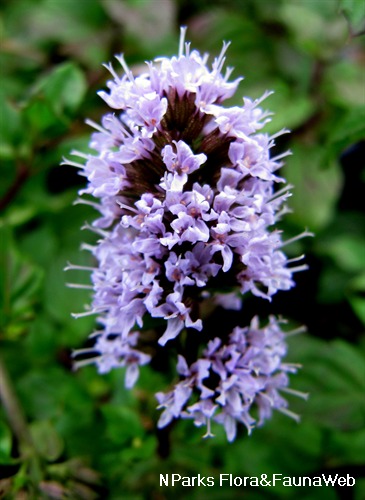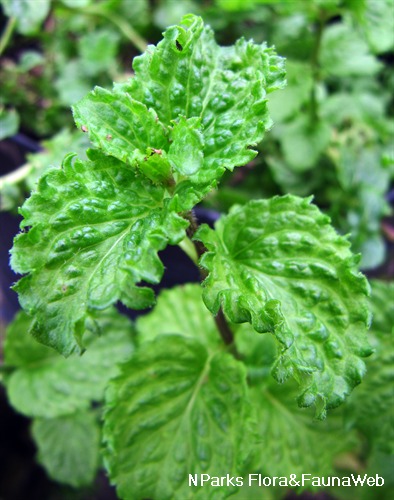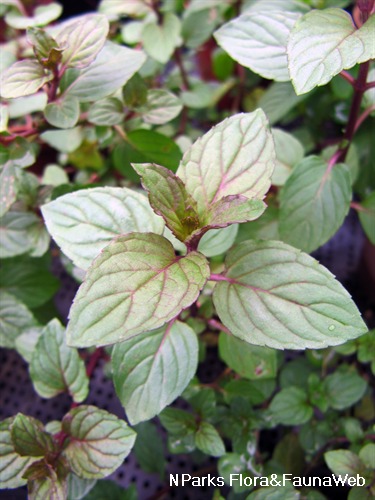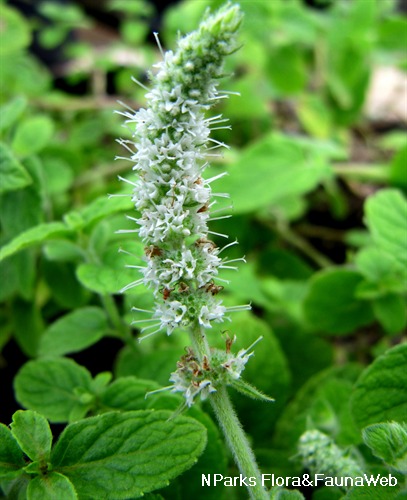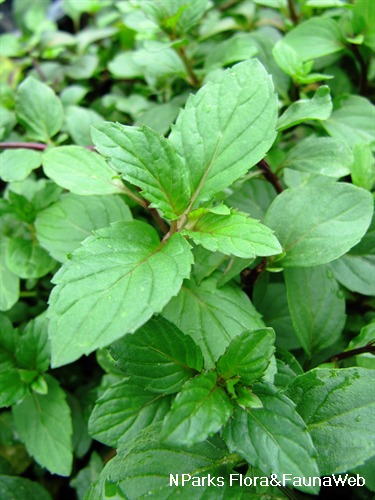
Back
Mentha × piperita f. citrata 'Chocolate'
| Family Name: | Lamiaceae (Labiatae) |
| Common Name: | Chocolate Mint, 巧克力薄荷 |
Name
Classifications and Characteristics
| Plant Division | Angiosperms (Flowering Seed Plants) (Dicotyledon) |
|---|---|
| Plant Growth Form | Shrub |
| Lifespan (in Singapore) | Perennial |
| Mode of Nutrition | Autotrophic |
| Maximum Height | 0.3 m to 0.6 m |
| Maximum Plant Spread / Crown Width | 0.3 m to 0.6 m |
Biogeography
| Native Distribution | This cultivar is of horticultural origin. |
|---|---|
| Preferred Climate Zone | Temperate |
| Local Conservation Status | Non-native (Horticultural / Cultivated Only) |
Description and Ethnobotany
| Growth Form | Perennial herb forming erect clumps up to 0.6 m tall. |
|---|---|
| Foliage | Smooth, dark green leaves with purplish to brownish tints are round to lance-shaped with toothed leaf margin. |
| Stems | Stems are round and reddish purple. |
| Flowers | Mauve-coloured flowers are light purple to purplish pink. |
| Taxonomy | This cultivar was selected from a cross of Watermint (Mentha aquatica) and Spearmint (Mentha spicata). |
| Cultivation | This cultivar grows best in moist, but well-drained soil that is enriched with compost. It can grow aggressively, so you might want to pot it in a container before planting it in the ground. To obtain leaves with the best flavour, place the plant where it can receive 5-6 hours of direct sun and remove flower spikes as they emerge. |
| Ethnobotanical Uses | Edible Plant Parts : Edible Leaves Food (Herb or Spice): The leaves have a light chocolate taste and aroma. It is often used in desserts or as a garnish. To store the leaves for later use, you can freeze or air-dry them. To air-dry, hang a bundle of stems upside down or spread them on a tray until dry, and then store them in an airtight container. |
Landscaping Features
| Desirable Plant Features | Ornamental Flowers |
|---|---|
| Landscape Uses | General, Container Planting |
| Thematic Landscaping | Economic Garden |
Plant Care and Propagation
| Light Preference | Full Sun |
|---|---|
| Water Preference | Lots of Water, Moderate Water |
| Rootzone Tolerance | Moist Soils, Well-Drained Soils, Fertile Loamy Soils |
| Pruning | Remove flower spikes to encourage new vegetative growth. |
| Propagation Method | Stem Cutting |
Foliar
| Foliage Retention | Evergreen |
|---|---|
| Mature Foliage Colour(s) | Green |
| Mature Foliage Texture(s) | Smooth |
| Prominent Young Flush Colour(s) | Green |
| Young Flush Texture(s) | Smooth |
| Foliar Type | Simple / Unifoliate |
| Foliar Arrangement Along Stem | Opposite |
| Foliar Attachment to Stem | Petiolate |
| Foliar Shape(s) | Non-Palm Foliage (Lanceolate) |
| Foliar Venation | Pinnate / Net |
| Foliar Margin | Serrate / Toothed |
| Foliar Apex - Tip | Acute |
| Foliar Base | Rounded / Obtuse |
| Leaf Area Index (LAI) for Green Plot Ratio | 4.5 (Shrub & Groundcover - Dicot) |
Floral (Angiosperm)
| Flower Colour(s) | Purple |
|---|---|
| Flower Texture(s) | Smooth |
| Flower Grouping | Cluster / Inflorescence |
| Flower Location | Terminal |
| Individual Flower Shape | Tubular |
| Inflorescence Type | Spike |
Image Repository
Others
| Master ID | 31121 |
|---|---|
| Species ID | 5512 |
| Flora Disclaimer | The information in this website has been compiled from reliable sources, such as reference works on medicinal plants. It is not a substitute for medical advice or treatment and NParks does not purport to provide any medical advice. Readers should always consult his/her physician before using or consuming a plant for medicinal purposes. |

.jpg)
.jpg)
